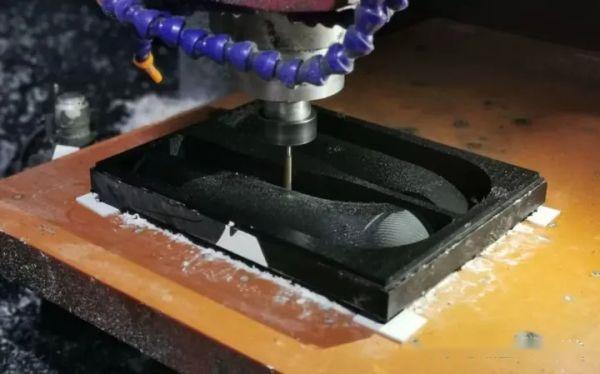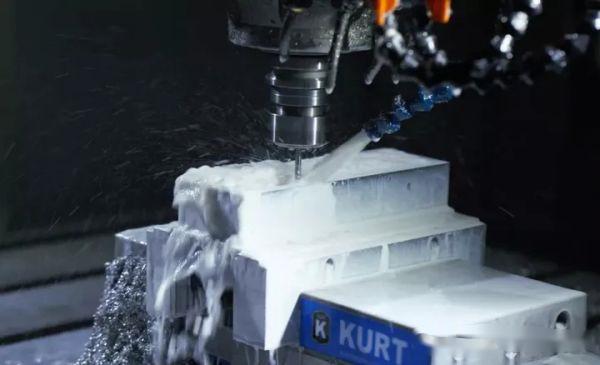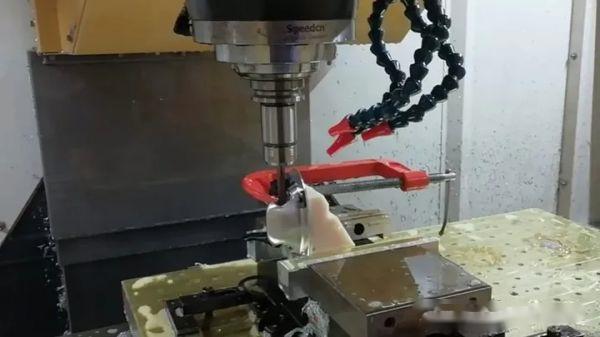
Privacy statement: Your privacy is very important to Us. Our company promises not to disclose your personal information to any external company with out your explicit permission.
When manufacturing CNC machined parts, it is important to first find out the best way to load and hold the workpiece. This step occurs before drawing the tool path and plays an important role in the process.
Workpiece clamping and loading are critical aspects of the CNC machining process. Your workpiece is only as good as how well it stands and stabilizes on the machine's work surface. As a result, machinists and engineers have come up with a variety of solutions to keep the workpiece stable.
In this article, we'll take a look at some of the best-known workpiece clamping methods, evaluating the advantages and disadvantages of each.
T-slots
T-slots are essential for workpiece clamping, providing a T-shaped cutout where the T-shaped crossbar sits on the underside of the table or within the table itself. This allows a nut to be fitted into the slot to provide a removable position for inserting a bolt or fixture.
There are many different types of fixtures, each with their own advantages and disadvantages.
Join with glue
Adding gluewood blocks to a workbench is a popular method of clamping workpieces, especially for prototyping. Workpieces can be easily glued to a glued wood workbench, as most Chinese prototyping companies do.
Gluing is still a very simple and popular solution for workpiece clamping. It can be used for flat and irregularly shaped materials. It can provide more strength than carpet tape while eliminating the need for workpiece holding tabs. Removing parts from the bed requires the use of a paint scraper or manual stripping. Glue is especially useful for prototype machining and plastics.
Proper application of glue requires an even application to keep the workpiece level. It is a fast, inexpensive and effective option for workholding, but how it works varies depending on the materials used. For example, hot gluing sometimes removes chunks from materials such as foam and wood. The best way to prevent damage is to apply the glue selectively and apply it to areas that are aesthetically or functionally unimportant, or apply it in thin layers for easier removal.
Again, glue will harden more quickly on metal. One way to avoid the glue hardening too quickly when machining metal is to place the material on a non-metallic waste plate secured to the bed. The material should be on top so that the glue has a chance to adhere to both surfaces instead of hardening on its own.
Benefit: Multiple parts can be glued to the bench at once, which reduces operator workload. This is an effective way to create plastic or aluminum prototypes.
Cons: There is a risk of the part peeling off. Parts may also be damaged during disassembly.

Mossy
Bolts are a great way to hold a workpiece for machining directly with a T-table. Frankly, adding an aluminum block is even a better idea because it's easy to create threaded holes where needed. The threaded holes are flush with the fixture for better leveling and stability.
Items used to hold material in place include T-nuts, studs and flange nuts. Studs and nuts can be especially useful if the work surface has threaded inserts instead of T-slots. In these cases, bolts can be screwed into the inserts to hold fixtures of various designs in place.
Benefits: Bolting is a very stable method of holding a workpiece in place and you can then cut the workpiece very hard. Complex geometries will not be a problem to hold.
Cons: Using bolts requires additional material for the frame. Material waste can be significant when machining large parts and loading times are long. Hinge marks can be problematic when cutting parts from the frame.

Vises
Machinists often use a vise as a standard method of securing workpieces. When the tool is machining material, the vise usually holds the workpiece from either end, securing it between two jaws. They are particularly useful for parts that have straight edges, but they can also be applied to parts with rounded edges.
Depending on the type of vise, machining rounded edges may require the help of soft jaws that can be milled to support the workpiece. Modern vises are designed with a quick-switch base that allows the machinist to load the part from the CNC machine. Once the part is complete, the next batch of parts can be quickly loaded. Vises are also a popular choice in our CNC shop.
Benefits: Vises can cut at high speeds and make it easy to position workpieces when making repetitive parts. They are an efficient way to make large batches of CNC parts. You can also place multiple vises on a CNC machine to make different parts at once.
Cons: Parts must have regular geometry and parallel surfaces. Otherwise, customized jaws are required.

Folder
There are several types of clamps available for workpiece clamping during CNC machining. They include combination clamps, vices and C-clamps.
Combination clamps or "building block clamps" consist of a series of standardized designs, different functions, and different sizes of components. These machine tool fixtures can be assembled like building blocks to meet machining requirements. By their very nature, modular fixtures are very time efficient to design and manufacture and are therefore suitable for small production cycles. The combination fixture also has the advantages of high positioning accuracy, high clamping flexibility, reusability, energy and material saving, and low cost of use. It is ideally suited to small batch production where slightly complex shapes are required.
Another advantage of the fixture is the ability to modify specific components and replace them according to the specific requirements of the workpiece. For example, more versatility, greater standardization, ease of use and more reliable clamping can be achieved with the use of combination precision flat jaws. This type of precision flat jaw has the advantage of quick and easy mounting and clamping. Production lead times can be shortened and small lot production efficiency can be increased.
Simpler clamps (e.g., C-clamps) can be easily found at hardware stores. They are inexpensive and easy to use, but their simplicity has drawbacks. Clamping material on one side only can sometimes cause it to lift on the other side, so it's important to make sure the material is flat before machining it. Similarly, cutting pieces and parts out of the material can be tricky, requiring multiple clamps and possibly other methods of holding the material in place. For heavier projects, it's best to use different types of fixtures to streamline the workflow.
Other ways to improve these fixtures include using smooth fixture bases or using specialty magnetic materials. The latter is used in electromagnetic permanent fixtures and can be effective in improving machining efficiency on CNC machines and machining centers. Conventional fixtures can take up a lot of space with their positioning and clamping elements, but because electromagnetic permanent fixtures utilize the inherent magnetic force of the material, they do not have these space-consuming components. This can save a lot of hassle for a variety of machining operations and minimize blocking parts that can get in the way of the machine tool. However, care must be taken to ensure that the magnet's suction force is sufficient to resist cutting forces.
Hydraulic and pneumatic fixtures use an additional power source to correctly position, support and compress the workpiece with hydraulic or pneumatic components. As a result, they can accurately and quickly determine the mutual position of the machine and the cutting tool and adjust the workpiece. They can also offer other advantages, such as compactness, multi-station clamping, high-speed heavy cutting and automatic control, all of which speed up material processing. This provides them with additional utility, making them ideal for CNC machines, machining centers and flexible production lines.

Vacuum tables
Vacuum tables compress the workpiece by generating a compressive force - this compressive force is caused by the difference between the vacuum underneath the part and the atmospheric pressure pushing down from above. Vacuum tables are often the best solution for flatbed machining on CNC milling machines.
These tables are very accurate, flexible and efficient. They are suitable for a wide range of materials and are particularly useful for non-clampable materials such as high-tech composites or advanced synthetics. They also minimize obstacles in ways that fixtures and other solutions cannot, while also making setup and changeover more efficient.
However, vacuum tables have their drawbacks. Vacuum tables are best suited for flat materials, as parts with different geometries require additional preparation. Certain small parts may also not have enough surface area for the vacuum to accommodate them, although more advanced types of vacuum tables with more uniform or concentrated downward pull can handle these items.
Pros: Vacuum tables have very fast loading times and are suitable for non-clampable materials.
Cons: Most vacuum tables are only suitable for simple, flat parts.
Magnetic tables
Magnetic tables use a magnetic base to hold workpieces made from suitable metals. They are a popular solution for the mold and die manufacturing industry, as most mold cavities are made of steel. However, they are also used for steel workpieces for general CNC machining operations.
Most magnetic tables are electromagnetic, so the magnetic force can be stopped when machining is complete. They allow for quick setup and excellent cutting tool operation since no physical fixtures or other equipment is required. They are suitable for light or heavy machining, but cannot be used for non-magnetic workpieces (e.g. aluminum).
Benefits: Magnetic tables allow for full cuts and can be set up quickly. They are also very safe and reliable.
Cons: Magnetic tables can only be used on magnetic metals, limiting their use in aluminum-based manufacturing.
Customized Clamping
When milling large volume parts, standard workpiece clamping methods may not be sufficient. If this is the case, it may be worth creating custom fixtures to CNC machine the part. Reducing time during mass production can make a big difference.
Fixtures can guide toolpaths and greatly improve product quality, but they are only needed when absolute stability is required. The workpiece is usually slid or dropped into the fixture and held in place with one or two quick clamps.
Custom manufactured workpiece fixtures offer distinct advantages and can be manufactured in a variety of ways. Fixtures that require high stiffness and tight geometric tolerances are best manufactured using CNC machining, while fixtures designed to conform to curved parts may be easier to produce via FDM or SLS 3D printing.
Pros: Custom fixtures can be tailored for oversized or irregular workpieces, reducing setup time and ensuring stability.
Cons: Extended turnaround time and increased expenses. These fixtures are not suitable for other common parts.
November 17, 2024
November 16, 2024
August 27, 2021
August 26, 2021
PEEK ball is a special type of ball made of polyether ether ketone (PEEK), which has excellent chemical stability, abrasion resistance, and high temperature resistance.PEEK ball is widely used in...
PVDF Application Areas Different models of PVDF products are suitable for different application scenarios. According to application fields, PVDF can be divided into conventional grade products and...
Application Performance Advantages of MC nylon MC nylon is a new type of engineering plastics, due to its outstanding comprehensive performance, so that its status in engineering plastics is rapidly...
Types of nylon: 1. Nylon - 6 (PA6) Nylon -6, also known as polyamide -6, that is, polycaprolactam. Translucent or opaque opalescent resin. 2. Nylon - 66 (PA66) Nylon-66, also known as polyamide-66,...
Email to this supplier
November 17, 2024
November 16, 2024
August 27, 2021
August 26, 2021

Privacy statement: Your privacy is very important to Us. Our company promises not to disclose your personal information to any external company with out your explicit permission.

Fill in more information so that we can get in touch with you faster
Privacy statement: Your privacy is very important to Us. Our company promises not to disclose your personal information to any external company with out your explicit permission.